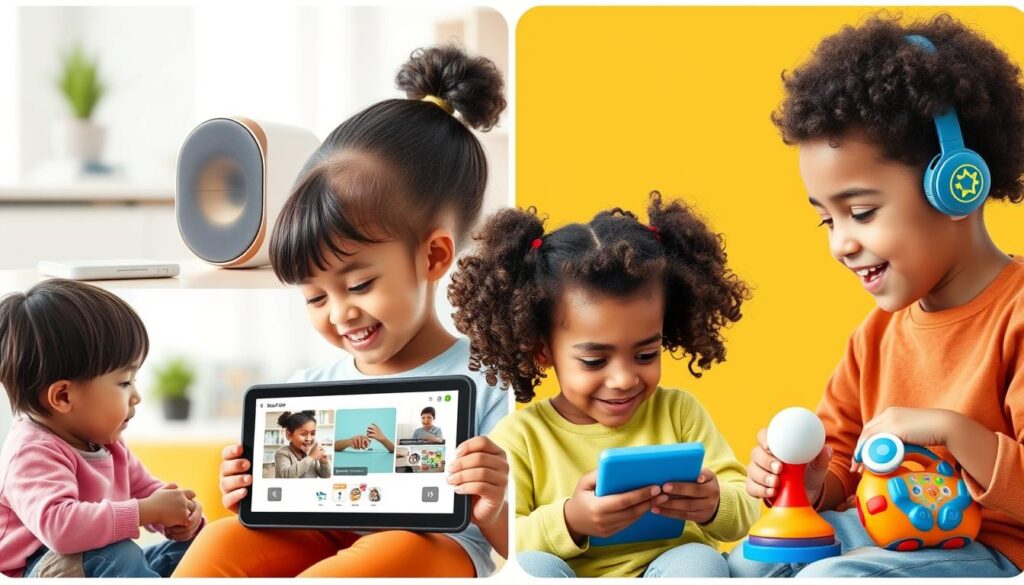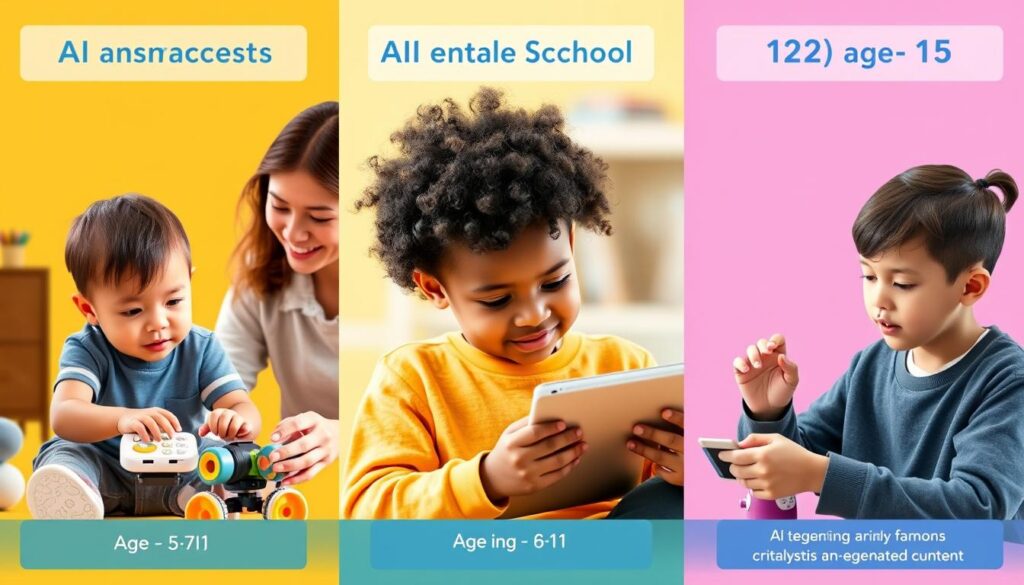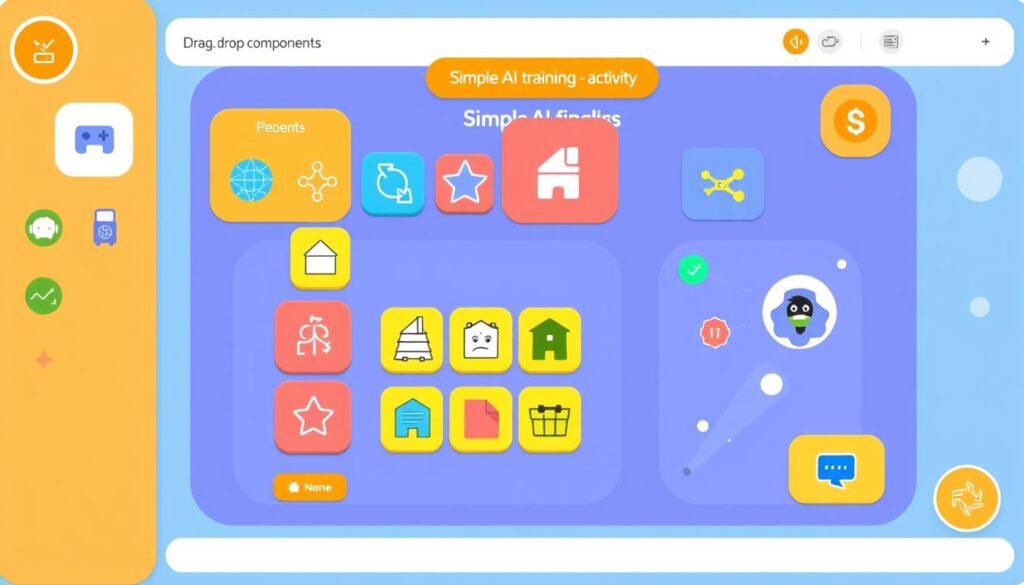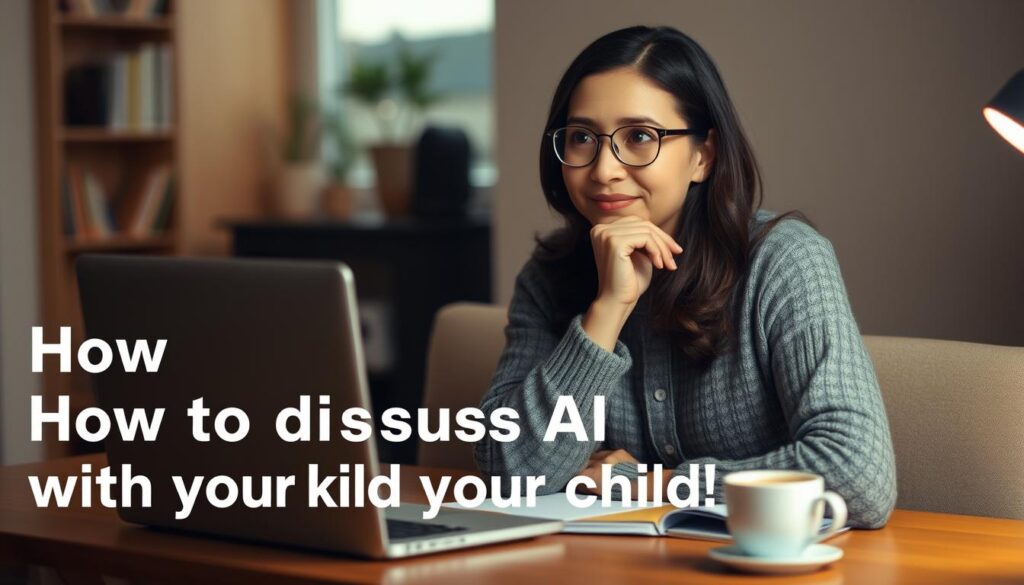From voice assistants answering homework questions to algorithms suggesting the next YouTube video, artificial intelligence is already woven into our children’s daily lives. Yet many parents feel uncertain about how to discuss this complex technology with kids. How do you explain something that even adults find challenging to understand? And how do you address the “robot takeover” fears without causing more anxiety?
The good news is that you don’t need a computer science degree to have meaningful conversations about AI with your children. This guide will help you explain artificial intelligence to kids ages 5-15 in ways that are reassuring, age-appropriate, and even fun. You’ll discover how to transform potentially intimidating tech talk into opportunities for connection and learning.
Starting conversations about AI early helps children develop a healthy relationship with technology
Why Talking About AI With Kids Matters
Children today are the first generation growing up in a world where artificial intelligence is commonplace. They’re interacting with AI through smart speakers, online games, homework help tools, and even their toys. According to research, many children already use AI tools like ChatGPT for schoolwork, often without fully understanding what they are.
Having open conversations about artificial intelligence helps kids:
- Develop critical thinking skills about the technology they use
- Understand the difference between AI capabilities and human intelligence
- Learn to use AI tools responsibly and ethically
- Feel empowered rather than intimidated by advancing technology
- Prepare for a future where AI will be even more prevalent
Most importantly, when parents initiate these conversations, they establish themselves as trusted guides in their child’s digital journey, making it more likely kids will come to them with questions or concerns in the future.
Free Resource: AI Conversation Starters
Download our printable guide with age-appropriate questions to kickstart meaningful discussions about artificial intelligence with your kids.
Starting Simple: Kid-Friendly Explanations of Artificial Intelligence
When introducing artificial intelligence to children, using relatable analogies can make this abstract concept more concrete. Here are some simple ways to explain AI based on your child’s age:

Using simple analogies helps children grasp how AI learns from examples
For Young Children (Ages 5-7)
“Artificial intelligence is like a super-smart helper that learns from examples. Imagine you’re teaching a new friend how to tell the difference between apples and oranges. You show them lots of apples and oranges, and after a while, they can recognize them on their own. AI learns in a similar way—people give it lots of examples, and then it can recognize patterns and make decisions.”
For Elementary School Kids (Ages 8-11)
“AI is like a computer brain that can learn from information. When you ask Alexa or Siri a question, they use artificial intelligence to understand what you’re asking and find the answer. They’ve been trained by looking at millions of examples of questions and answers. The more examples they see, the better they get—kind of like how you get better at reading or math with practice.”
For Tweens and Teens (Ages 12-15)
“Artificial intelligence is technology that allows computers to perform tasks that normally require human intelligence—like recognizing speech, making decisions, or finding patterns in information. AI systems learn from data, which means they analyze huge amounts of information to find patterns and make predictions. For example, when Netflix suggests shows you might like, it’s using AI to analyze what you’ve watched before and predict what you might enjoy next.”
Parent’s Cheat Sheet: AI Basics
- Artificial Intelligence = Computer systems that can perform tasks that typically require human intelligence
- Machine Learning = Teaching computers to learn from data and improve over time
- Algorithm = A set of instructions that tells a computer how to solve a problem
- Neural Network = Computer systems inspired by the human brain that can recognize patterns
- Training Data = Information used to teach AI systems how to make decisions
Addressing AI Fears Without Adding Anxiety
Children are naturally curious, and many have been exposed to science fiction portrayals of AI that can fuel misconceptions. It’s important to address these concerns directly but reassuringly.

Creating a safe space for questions helps children process information about AI without fear
Common Questions Kids Ask About AI
“Will robots take over the world?”
“The robots and AI we have today are designed to help with specific tasks, like vacuuming the floor or answering questions. They’re tools created by people to solve problems. They don’t have their own goals or desires like humans do. The AI in movies that tries to take over is science fiction—it’s made up for entertainment, just like dragons or superheroes.”
“Can AI think like people?”
“AI can do things that look like thinking, but it works differently than our brains. It’s more like a really good guesser that uses patterns from information it’s seen before. AI doesn’t have feelings, consciousness, or creativity like humans. It can write a story based on patterns from other stories, but it doesn’t understand what the story means or feel proud of creating it.”
“Will AI take away people’s jobs?”
“Technology has always changed the kinds of jobs people do. When we invented cars, we needed fewer horse carriage drivers but more mechanics and car designers. AI might change some jobs, but it will also create new ones we haven’t even thought of yet. The most important thing is to keep learning new skills throughout your life, which is something you’re already good at!”
“The goal isn’t to make children fear AI or to give them unrealistic expectations. Instead, we want to help them understand AI as a tool created by humans that has both possibilities and limitations.”
Real-World AI Examples Kids Already Use
One of the most effective ways to explain artificial intelligence to children is to point out how they’re already interacting with it. This makes the concept less abstract and helps them connect it to their everyday experiences.

Children interact with artificial intelligence in many ways throughout their daily routines
AI at Home
- Voice Assistants: “When you ask Alexa or Siri a question, they use AI to understand your words and find answers.”
- Smart Home Devices: “Our thermostat learns what temperatures we like at different times of day.”
- Streaming Services: “Netflix suggests shows based on what you’ve watched before.”
- Smart Toys: “Your interactive stuffed animal uses AI to respond to your voice and movements.”
AI in School and Play
- Learning Apps: “Your math app adjusts problems based on what you find difficult.”
- Video Games: “The characters in your game use AI to make decisions and respond to your actions.”
- Search Engines: “When you search for information online, AI helps find the most relevant answers.”
- Photo Filters: “The funny face filters on photos use AI to detect and transform your features.”
Activity Idea: AI Scavenger Hunt
Create a family scavenger hunt to identify AI in your home. Have children list all the devices and applications they think might use artificial intelligence, then discuss how each one works. This helps make AI more concrete and less mysterious.
Age-Appropriate AI Activities
Download our collection of hands-on activities that help children understand artificial intelligence through play and exploration.
Teaching Kids About AI Ethics and Limitations
As children learn about artificial intelligence, it’s important they understand that AI systems have limitations and ethical considerations. This helps them develop a balanced view and use AI tools responsibly.

Discussing AI ethics helps children develop critical thinking skills about technology
AI Isn’t Perfect: Explaining Limitations
Help children understand that artificial intelligence has limitations by using simple explanations:
- AI Makes Mistakes: “AI is only as good as the information it learns from. If that information has errors or is incomplete, the AI can make mistakes.”
- AI Doesn’t Truly Understand: “When ChatGPT writes a story, it doesn’t understand the characters’ feelings or the meaning of the story—it’s just predicting what words should come next based on patterns.”
- AI Needs Human Oversight: “That’s why we always need people to check AI’s work and make the final decisions, especially for important things.”
Explaining Bias in Kid-Friendly Terms
“Imagine if someone only ever showed you pictures of cats that were black. If they then asked you to draw a cat, you’d probably draw a black one because that’s all you’ve seen. AI works similarly—if it only sees certain types of information, its answers will reflect that limited view. This is why AI sometimes gives answers that aren’t fair to everyone.”
Privacy Conversations
Explain to children that AI systems often remember the questions we ask and the information we share:
- “When you talk to an AI like Alexa or use a chatbot, it might save what you say to learn and get better.”
- “That’s why we should be careful about sharing personal information with AI, just like we’re careful online.”
- “Always ask a grown-up before sharing your name, address, or photos with any technology.”
Critical Thinking Skills
Help children develop habits for evaluating AI-generated information:
- “When AI gives you information, ask yourself: Does this make sense? How can I check if it’s correct?”
- “Remember that AI can sometimes make up answers that sound real but aren’t true.”
- “It’s always good to check important information from multiple sources, not just AI.”
Important Reminder
Most AI tools have age restrictions (typically 13+) because they weren’t designed with children in mind. If your younger child is using these tools, ensure you’re providing supervision and guidance.
Age-Specific Approaches to Discussing Artificial Intelligence
Children at different developmental stages have varying capacities for understanding complex concepts. Here’s how to tailor your artificial intelligence discussions based on your child’s age:

Conversations about AI should evolve as children grow and develop more complex understanding
For Young Children (Ages 5-7)
At this age, keep explanations simple and concrete, focusing on AI as a helpful tool:
- Use storybooks about friendly robots or AI helpers
- Point out AI in their daily life: “The speaker understood your question because it uses artificial intelligence”
- Emphasize that AI is created by people to help with tasks
- Use simple activities like sorting games to explain how AI learns to categorize things
For Elementary School Kids (Ages 8-11)
Children at this age can understand more about how AI works and begin to think critically about it:
- Introduce basic concepts of how AI learns from data
- Discuss both helpful uses of AI and potential problems
- Try simple coding games that introduce AI concepts
- Talk about how to verify information from AI sources
- Discuss privacy in simple terms: “Some information is just for our family to know”
For Tweens and Teens (Ages 12-15)
Older children can engage with more complex ethical and social questions about artificial intelligence:
- Discuss how AI might impact future careers and society
- Explore ethical questions about AI decision-making
- Talk about responsible use of AI for schoolwork
- Analyze media portrayals of AI versus reality
- Encourage critical thinking about AI-generated content they encounter
Age-Appropriate Conversation Guides
Download our detailed guides with specific conversation starters, activities, and resources tailored to your child’s age group.
Hands-On Activities to Explore Artificial Intelligence Together
One of the best ways to help children understand artificial intelligence is through interactive, hands-on experiences. These activities make abstract concepts tangible and create opportunities for meaningful discussions.

Hands-on activities make abstract AI concepts concrete and memorable for children
Simple AI Experiments for Families
Guess What I’m Thinking
Play a game where you think of a category (animals, foods, etc.) and have your child ask yes/no questions to figure it out. After playing, explain that this is similar to how AI narrows down possibilities based on data.
AI Art Comparison
Use a kid-friendly AI art generator to create images. Then have your child draw the same prompt. Compare the results and discuss how the AI “learned” to create art versus how humans create art with imagination and emotion.
Pattern Detective
Create a sequence of shapes or numbers with a pattern. Ask your child to predict what comes next, then explain that AI looks for patterns in data to make predictions about what might happen next.
Online Resources and Tools
These kid-friendly resources can help children explore artificial intelligence concepts:
- Machine Learning for Kids – Interactive projects that let children train simple AI models
- Code.org AI Lab – Free courses that introduce AI concepts through coding activities
- Common Sense Education AI Resources – Age-appropriate activities and discussion guides
- Crash Course AI – Video series explaining AI concepts (best for teens)

Online platforms make learning about AI interactive and engaging for children of all ages
Book Recommendations
These books can help introduce AI concepts to children:
- “How to Train Your Robot” by Blooma Goldberg (ages 5-8)
- “Awesome Minds: The Creators of Artificial Intelligence” by Marne Ventura (ages 8-12)
- “AI and Machine Learning for Kids” by Dale Green (ages 10-14)
- “Hello Ruby: Expedition to the Internet” by Linda Liukas (ages 5-8)
Parent FAQs: Your Questions About Discussing AI With Kids

Many parents share common questions about introducing artificial intelligence concepts to children
At what age should I start talking to my child about artificial intelligence?
You can begin introducing simple AI concepts as early as 5-6 years old, focusing on identifying AI in their daily lives (like voice assistants or smart toys). The key is to use age-appropriate language and examples they can relate to. As with most topics, it’s better to start these conversations early and build upon them as your child grows, rather than waiting until they’ve already formed misconceptions from other sources.
How do I explain AI ethics to my child without making it too complicated?
Start with simple concepts of fairness that children already understand. For example, “If an AI only learned from stories about boys having adventures, it might think girls don’t have adventures too. That wouldn’t be fair, right?” As they get older, you can introduce more complex ideas about bias, privacy, and the importance of human oversight. Using relatable examples from their own experiences helps make these abstract concepts more concrete.
My child is using AI for homework. Should I be concerned?
This depends on how they’re using it. AI can be a valuable learning tool when used to understand concepts better, brainstorm ideas, or check work. However, it shouldn’t replace the learning process itself. Have open conversations about when using AI is helpful versus when it might prevent learning. Check with your child’s school about their policies, as many are developing guidelines for appropriate AI use. The goal should be teaching responsible use rather than prohibition.
How do I keep up with AI developments to guide my child when I don’t fully understand it myself?
You don’t need to be an expert to have valuable conversations about artificial intelligence. Focus on the basic concepts and ethical considerations, which change less rapidly than the technology itself. Consider learning alongside your child—try some of the family activities mentioned in this article together. Resources like Common Sense Media, Family Online Safety Institute, and PBS Kids for Parents regularly publish updated, parent-friendly information about AI and other digital topics.
My child is afraid of AI after seeing something scary in a movie. How do I reassure them?
First, validate their feelings—it’s okay to feel concerned about new technology. Then, help them distinguish between science fiction and reality. Explain that the AI in movies is very different from the AI we have today. Show them positive, helpful examples of AI in their daily life. For younger children, books with friendly robot characters can help create positive associations. Most importantly, reassure them that humans create and control AI tools, and that you’re there to help them navigate this technology safely.
Have More Questions?
Download our comprehensive parent guide with additional FAQs, resources, and expert advice on navigating artificial intelligence with your family.
Empowering Your Child in an AI-Powered World
Conversations about artificial intelligence aren’t just about explaining technology—they’re about preparing children for a world where AI will be increasingly present in their education, future careers, and daily lives. By discussing these topics openly and age-appropriately, you’re helping your child develop the critical thinking skills they’ll need to navigate this technology confidently.

Building AI literacy helps children become confident, critical users of technology
Remember these key takeaways as you discuss artificial intelligence with your children:
- Keep it positive: Frame AI as a tool that can solve problems and create opportunities
- Be honest about limitations: Help children understand that AI has both strengths and weaknesses
- Encourage questions: Create an environment where children feel comfortable expressing curiosity or concerns
- Learn together: You don’t need to have all the answers—exploring AI concepts together can be a bonding experience
- Focus on ethics: Help children develop a framework for thinking about how technology should be used responsibly
By having these conversations now, you’re helping your child develop a healthy, balanced relationship with artificial intelligence—one that recognizes both its potential benefits and its limitations. This foundation of understanding will serve them well as they grow up in a world increasingly shaped by this technology.
“The goal isn’t to raise children who are merely consumers of AI, but rather thoughtful digital citizens who can use these tools wisely and perhaps even help shape how they evolve in the future.”
Continue the Conversation
Access our complete library of resources for families navigating the digital age, including guides, activities, and expert advice on artificial intelligence and beyond.







